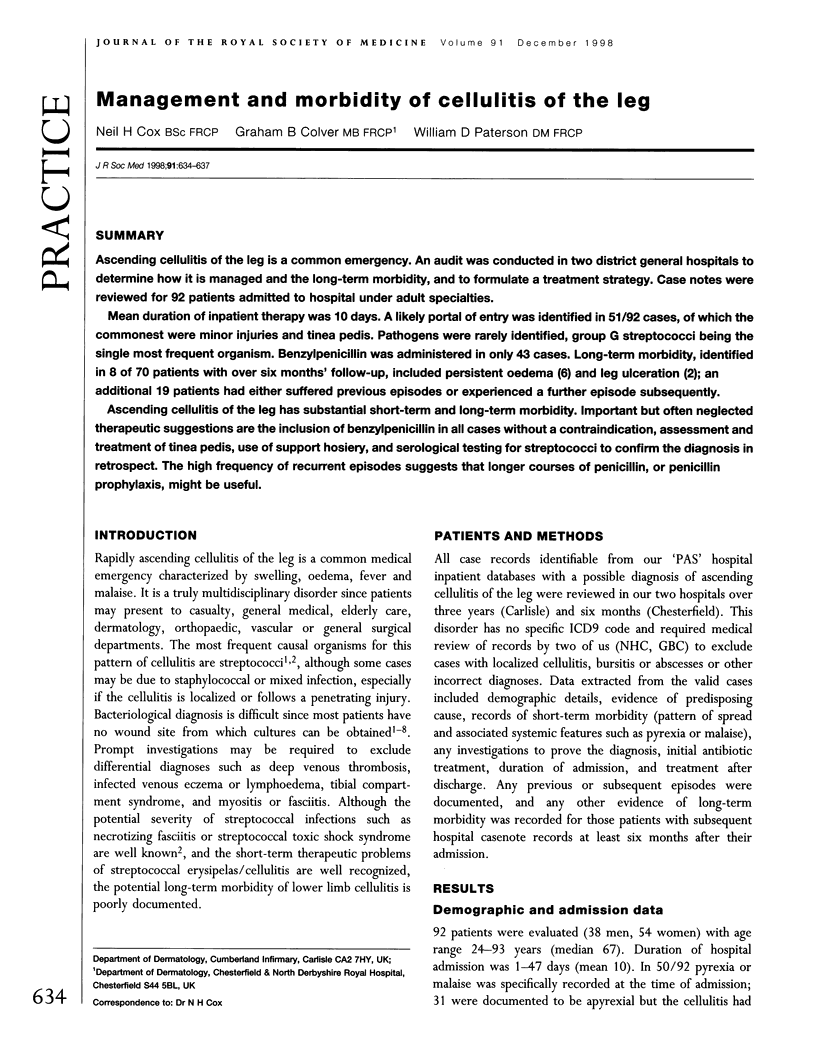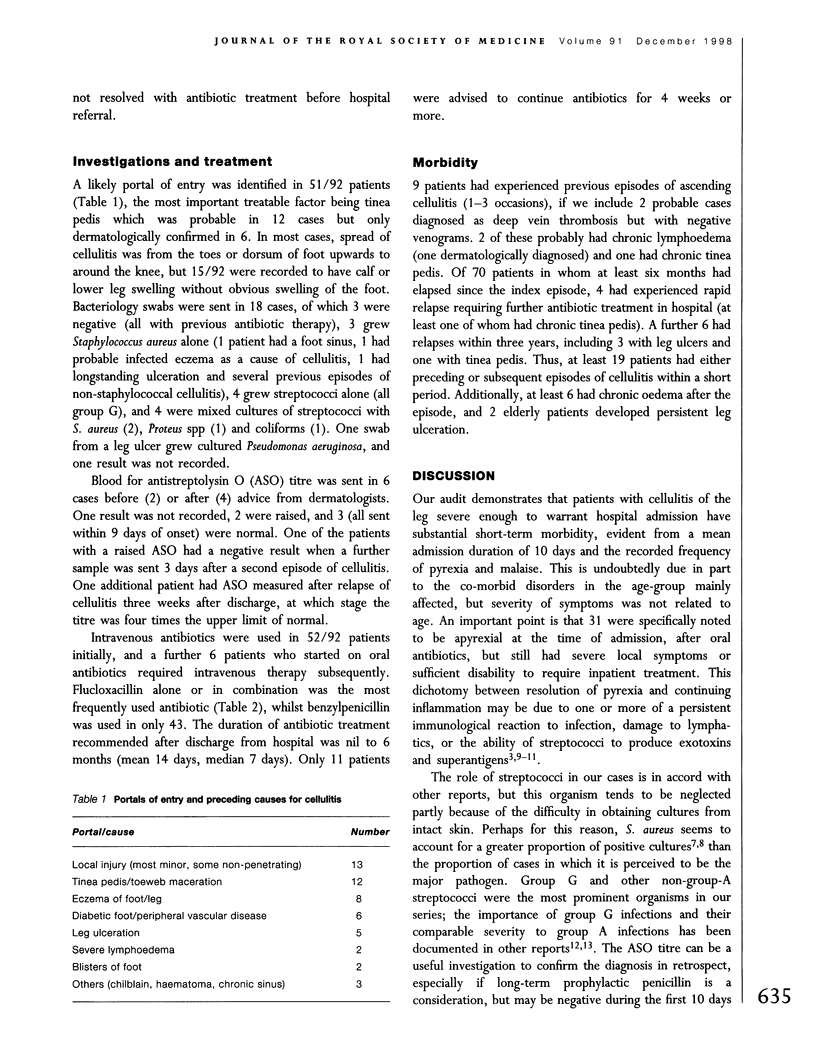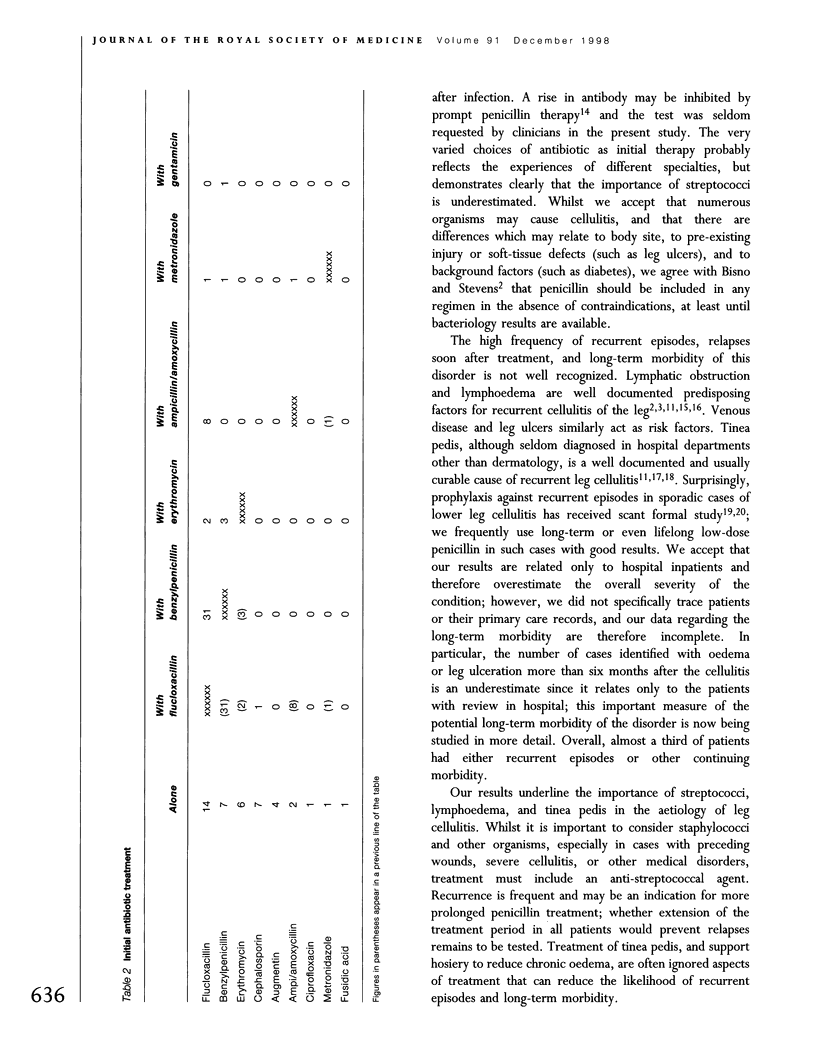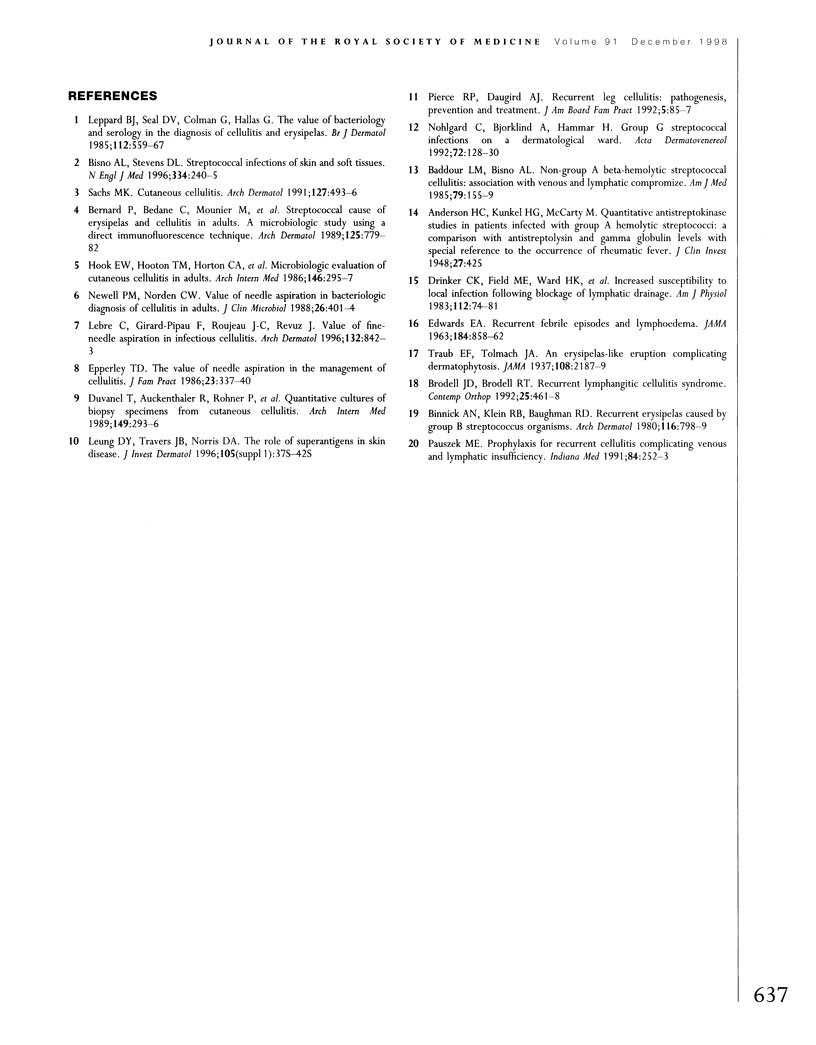Abstract
Ascending cellulitis of the leg is a common emergency. An audit was conducted in two district general hospitals to determine how it is managed and the long-term morbidity, and to formulate a treatment strategy. Case notes were reviewed for 92 patients admitted to hospital under adult specialties. Mean duration of inpatient therapy was 10 days. A likely portal of entry was identified in 51/92 cases, of which the commonest were minor injuries and tinea pedis. Pathogens were rarely identified, group G streptococci being the single most frequent organism. Benzylpenicillin was administered in only 43 cases. Long-term morbidity, identified in 8 of 70 patients with over six months' follow-up, included persistent oedema (6) and leg ulceration (2); an additional 19 patients had either suffered previous episodes or experienced a further episode subsequently. Ascending cellulitis of the leg has substantial short-term and long-term morbidity. Important but often neglected therapeutic suggestions are the inclusion of benzylpenicillin in all cases without a contraindication, assessment and treatment of tinea pedis, use of support hosiery, and serological testing for streptococci to confirm the diagnosis in retrospect. The high frequency of recurrent episodes suggests that longer courses of penicillin, or penicillin prophylaxis, might be useful.
Full text
PDF



Selected References
These references are in PubMed. This may not be the complete list of references from this article.
- Anderson H. C., Kunkel H. G., McCarty M. QUANTITATIVE ANTISTREPTOKINASE STUDIES IN PATIENTS INFECTED WITH GROUP A HEMOLYTIC STREPTOCOCCI: A COMPARISON WITH SERUM ANTISTREPTOLYSIN AND GAMMA GLOBULIN LEVELS WITH SPECIAL REFERENCE TO THE OCCURRENCE OF RHEUMATIC FEVER. J Clin Invest. 1948 Jul;27(4):425–434. doi: 10.1172/JCI101986. [DOI] [PMC free article] [PubMed] [Google Scholar]
- Baddour L. M., Bisno A. L. Non-group A beta-hemolytic streptococcal cellulitis. Association with venous and lymphatic compromise. Am J Med. 1985 Aug;79(2):155–159. doi: 10.1016/0002-9343(85)90003-8. [DOI] [PubMed] [Google Scholar]
- Bernard P., Bedane C., Mounier M., Denis F., Catanzano G., Bonnetblanc J. M. Streptococcal cause of erysipelas and cellulitis in adults. A microbiologic study using a direct immunofluorescence technique. Arch Dermatol. 1989 Jun;125(6):779–782. [PubMed] [Google Scholar]
- Binnick A. N., Klein R. B., Baughman R. D. Recurrent erysipelas caused by group B streptococcus organisms. Arch Dermatol. 1980 Jul;116(7):798–799. [PubMed] [Google Scholar]
- Bisno A. L., Stevens D. L. Streptococcal infections of skin and soft tissues. N Engl J Med. 1996 Jan 25;334(4):240–245. doi: 10.1056/NEJM199601253340407. [DOI] [PubMed] [Google Scholar]
- Duvanel T., Auckenthaler R., Rohner P., Harms M., Saurat J. H. Quantitative cultures of biopsy specimens from cutaneous cellulitis. Arch Intern Med. 1989 Feb;149(2):293–296. [PubMed] [Google Scholar]
- Epperly T. D. The value of needle aspiration in the management of cellulitis. J Fam Pract. 1986 Oct;23(4):337–340. [PubMed] [Google Scholar]
- Hook E. W., 3rd, Hooton T. M., Horton C. A., Coyle M. B., Ramsey P. G., Turck M. Microbiologic evaluation of cutaneous cellulitis in adults. Arch Intern Med. 1986 Feb;146(2):295–297. [PubMed] [Google Scholar]
- Lebre C., Girard-Pipau F., Roujeau J. C., Revuz J., Saiag P., Chosidow O. Value of fine-needle aspiration in infectious cellulitis. Arch Dermatol. 1996 Jul;132(7):842–843. [PubMed] [Google Scholar]
- Leppard B. J., Seal D. V., Colman G., Hallas G. The value of bacteriology and serology in the diagnosis of cellulitis and erysipelas. Br J Dermatol. 1985 May;112(5):559–567. doi: 10.1111/j.1365-2133.1985.tb15264.x. [DOI] [PubMed] [Google Scholar]
- Leung D. Y., Travers J. B., Norris D. A. The role of superantigens in skin disease. J Invest Dermatol. 1995 Jul;105(1 Suppl):37S–42S. doi: 10.1111/1523-1747.ep12315250. [DOI] [PubMed] [Google Scholar]
- Newell P. M., Norden C. W. Value of needle aspiration in bacteriologic diagnosis of cellulitis in adults. J Clin Microbiol. 1988 Mar;26(3):401–404. doi: 10.1128/jcm.26.3.401-404.1988. [DOI] [PMC free article] [PubMed] [Google Scholar]
- Nohlgård C., Björklind A., Hammar H. Group G streptococcal infections on a dermatological ward. Acta Derm Venereol. 1992;72(2):128–130. [PubMed] [Google Scholar]
- Pauszek M. E. Prophylaxis for recurrent cellulitis complicating venous and lymphatic insufficiency. Indiana Med. 1991 Apr;84(4):252–253. [PubMed] [Google Scholar]
- Pierce R. P., Daugird A. J. Recurrent leg cellulitis: pathogenesis, treatment, and prevention. J Am Board Fam Pract. 1992 Jan-Feb;5(1):85–87. [PubMed] [Google Scholar]
- Sachs M. K. Cutaneous cellulitis. Arch Dermatol. 1991 Apr;127(4):493–496. [PubMed] [Google Scholar]


